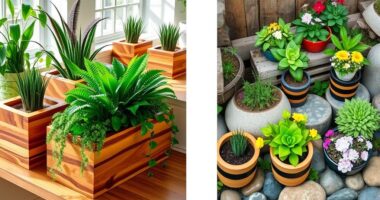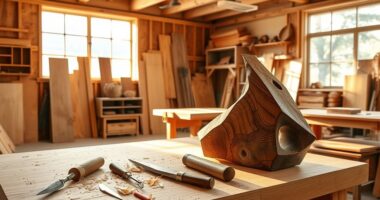Discover a variety of wooden toys that inspire STEM learning through creative play. You can find puzzles that develop problem-solving skills, building blocks that encourage engineering concepts, and balance scales that teach about symmetry and measurement. Many of these toys are crafted from sustainable materials, ensuring safety and durability. As you explore, you’ll see how simple designs can foster critical thinking, spatial awareness, and curiosity. Keep exploring to uncover more innovative ways these toys boost learning and fun.
Key Takeaways
- Many wooden toys incorporate balance, symmetry, and mechanics to subtly teach foundational STEM principles.
- Building blocks and construction sets promote engineering skills and problem-solving through creative assembly.
- Toys designed for various developmental stages support progressive learning in STEM concepts.
- Responsibly sourced, eco-friendly wood ensures safe, sustainable play that aligns with environmental values.
- Tactile, durable materials enhance sensory development while fostering curiosity in STEM topics.

Wooden toys have long been cherished for their durability and timeless appeal, but today they also serve an important educational purpose. When you choose wooden toys that incorporate sustainable materials, you’re not only investing in a product that lasts but also supporting environmentally friendly practices. These toys are crafted from responsibly sourced wood, which reduces your carbon footprint and promotes conservation. Additionally, sustainable materials ensure that the toys remain free of harmful chemicals, making them safer for your child and better for the planet. An essential aspect of these toys is their age-appropriate design. When you select toys tailored to your child’s developmental stage, you foster engagement and learning without frustration or safety concerns. For younger children, simple puzzles or stacking blocks made from smooth, rounded wood encourage sensory exploration and fine motor skills. As children grow, more complex wooden construction sets or mechanical toys challenge their problem-solving abilities and inspire curiosity about engineering principles.
By focusing on age-appropriate design, you help your child develop confidence as they master new skills at the right pace. Wooden toys often feature intuitively designed shapes and sizes, making them easy for small hands to grasp and manipulate. This thoughtful design supports hand-eye coordination and spatial awareness, foundational skills for STEM learning. Furthermore, the tactile nature of wood enhances sensory development, which is vital in early childhood education. When choosing wooden toys that teach STEM concepts, it’s important to take into account their adaptability. Well-designed toys can evolve with your child’s growing skills, providing ongoing opportunities for learning. For example, a building block set might start as a simple stacking game and later be used for more complex constructions, encouraging creativity and engineering thinking.
The beauty of these toys lies in their ability to seamlessly blend play and education. They often incorporate elements that teach concepts like balance, symmetry, and mechanics without overwhelming young minds. When you select wooden toys made from sustainable materials and designed with your child’s age in mind, you’re fostering both environmental responsibility and a love for learning. These toys serve as durable, beautiful tools that can be passed down through generations, reinforcing timeless values of quality and sustainability. Moreover, selecting toys with sustainable materials ensures that you are supporting eco-conscious manufacturing practices, which benefits the planet in the long run. Ultimately, choosing the right wooden toys helps your child develop critical STEM skills in a safe, engaging, and eco-conscious way. This approach not only nurtures their curiosity but also instills a lifelong appreciation for thoughtful, sustainable design.
Frequently Asked Questions
Are Wooden STEM Toys Suitable for All Age Groups?
When considering if wooden STEM toys are suitable for all age groups, you should focus on age appropriateness and skill development. Younger children benefit from simple, colorful designs that foster basic motor skills and curiosity. Older kids can handle more complex challenges that promote critical thinking and problem-solving. These toys are versatile, helping each age group develop their abilities while ensuring safety and engagement throughout their growth stages.
How Do Wooden Toys Compare to Plastic STEM Toys?
When comparing wooden to plastic STEM toys, you might find yourself caught between a rock and a hard place. Wooden toys often boast superior durability and a timeless appeal, making them a long-lasting investment. On the other hand, plastic variety offers a wider range of colors and intricate designs. While plastic can sometimes be less sturdy, it provides versatility. Ultimately, your choice depends on durability, safety, and the kind of learning experience you want to foster.
Can Wooden STEM Toys Support Different Learning Styles?
You’ll find that wooden STEM toys support different learning styles by offering multisensory engagement and kinesthetic learning opportunities. These toys encourage hands-on exploration, helping tactile and visual learners grasp concepts more effectively. Unlike other materials, wood’s natural texture promotes sensory development, making learning more interactive. So, whether you’re a visual, auditory, or kinesthetic learner, wooden STEM toys can adapt to your needs, enhancing understanding through active, engaging play.
What Safety Standards Should Wooden STEM Toys Meet?
Think of safety standards as the sturdy backbone of any wooden toy. You should guarantee your wooden STEM toys meet strict wooden safety guidelines and toy regulations, including non-toxic paints and smooth edges. These standards act as a shield, protecting children from potential hazards. Always check for certifications like ASTM or CE, and prioritize quality craftsmanship. By doing so, you create a safe, engaging learning experience that parents can trust.
How Do Wooden Toys Impact Environmental Sustainability?
You might wonder about wooden toys and their environmental impact. Wooden toys, when made from recyclable materials and produced through eco-friendly manufacturing, support sustainability. They decompose naturally, reducing waste in landfills. Choosing these toys encourages responsible consumption and minimizes pollution. By opting for eco-conscious options, you help protect the environment, conserve resources, and promote a greener future for generations to come.
Conclusion
By exploring these wooden toys, you open a world of hands-on learning that fuels curiosity and creativity. As the saying goes, “A little hands-on experience is worth a thousand theories.” These toys not only entertain but also build foundational STEM skills that last a lifetime. So, pick up that wooden gear or puzzle today—because when you teach through play, you’re planting seeds for future innovators.









